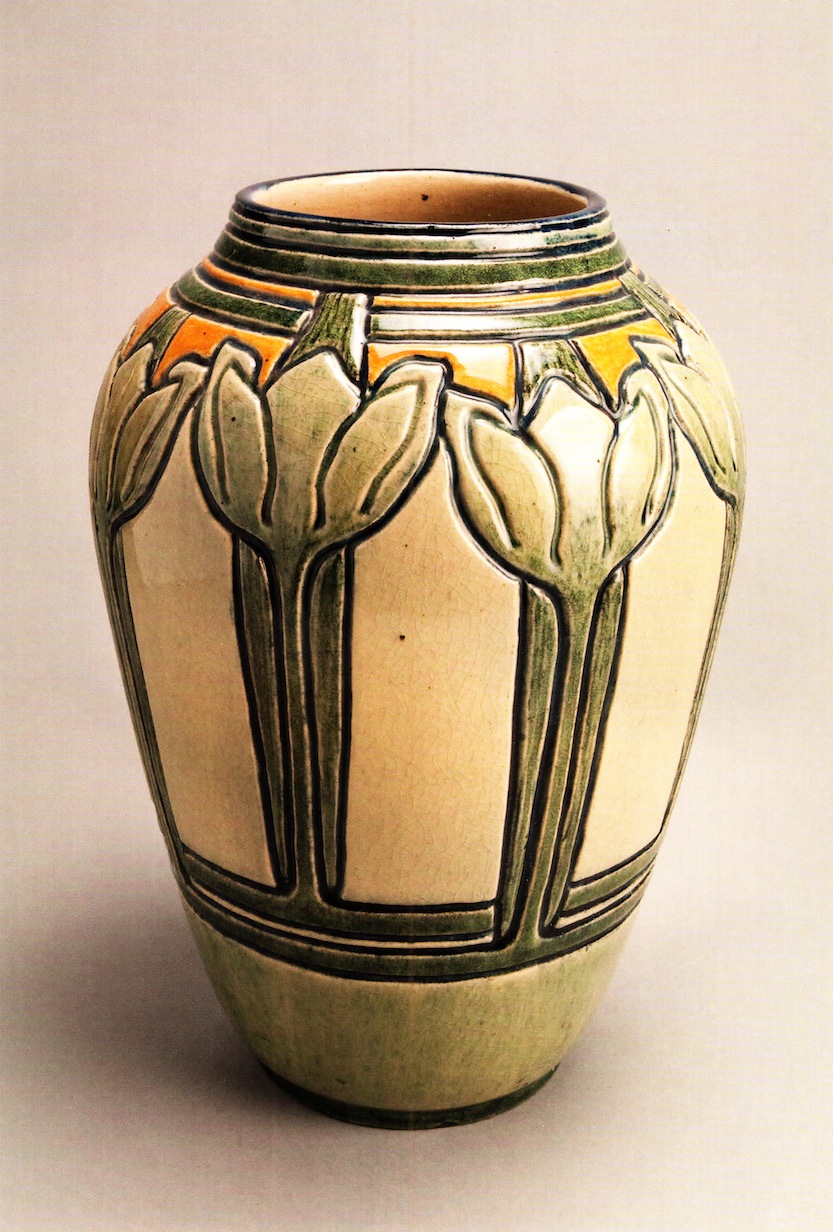
Newcomb Pottery:
A Visual Treasury
John Canaday
Suzanne Ormond
and Mary E. Irvine
(Pelican)

For those interested in the history of Art Pottery in the southern United States, it probably got its start at The World's Industrial and Cotton Centennial Exposition in 1884. Julia Ward Howe, that trouble-making suffragette, organized the women's department at the Exposition, and saw to it that there were classes and exhibitions of pottery, most inspired by the Arts and Crafts Movement.Wait! Your eyes are glazing over: but this particular glaze is worth it [see Fig 1 above]. Lady Gaga, one of the guiding philosophers of early 21st Century America, has this to say about Arts & Crafts: When you make music or write or create, it's really your job to have mind-blowing, irresponsible, condomless sex with whatever idea it is you're writing about at the time.
Meanwhile, back in New Orleans, Josephine Louise Newcomb gave money to start an art school so young ladies could have something to do with their hands to keep them from becoming trouble-making suffragettes. The ideas of William Morris and John Ruskin were in the air. Ruskin wrote, "Look for what is good and strong and try to imitate it. Your faults will drop off like dead leaves when their time comes." This is known as the autumnal school of art criticism, as opposed to Lady Gaga, who represented the condomless school. (Ruskin also came up with the oldest of hoary old mots: "It takes a great deal of living to get a little deal of learning.")
In 1885, New Orleans Art Pottery was being developed by the Ladies' Decorative Art League. Free classes were given twice a week. The guidelines for acceptable pottery were simple. "The pots were to be well-designed, one of a kind, hand-thrown and hand-decorated utilitarian pieces. Decoration was to be inspired by Louisiana flora and fauna. Local clays dug north of Lake Pontchartrain were used."
After several experiments, it was decided that the
preferred decoration method was to apply underglaze pigments to biscuit, or once-fired clay.
You've learned something new: a biscuit just isn't that round dough-ey thing on your plate, swimming along in the gravy. It's also "once-fired "clay. Apparently, most pots are fired more than once.
§ § § This book, Newcomb Pottery, is a comely, nicely wrought art book, fired but once. It's also novel. There are over 150 color photographs of historic pottery from New Orleans, thrown between 1895 and 1948 (when the school went out of business), and there is no commentary whatsoever --- outside of a very short introduction.
There are plates, bowls, inkwells, candle-sticks, humidors, flower-pots, figurines, and pitchers, all grandly photographed, many filling a whole page in perfect color. One of the best of these is a subtle, elegant pitcher decorated by Mazie T. Ryan in 1902 (Mazie, where are you now? I want to move in with you and have you fill our lake-side cottage with beautiful pitchers.)
Mazie's classmate Marie de Hoa LeBlanc, decorated a vase in the style of the century plant. Many of these decorations --- Rosa Montana vine, water-lily, day-lily, quince, snowbell, daffodil, chrysanthemum, and magnolia --- are lush and, at the same time, restrained, a key element of the Arts & Craft Movement. Do you know what I'm talking about? Me neither, but I wanted to get those gorgeous flowers in here somewhere.
There's a fine "low bowl" with a dragonfly design cooked up by Leona Nicholson, 1905, and I've just changed my mind, Mazie: I'm going to take up with Leona, if you don't mind . . . if she doesn't mind a slightly older but comely lady with a penchant for women who can make a low, low low bowl.
None of these pots were actually fired by their designers. Joseph Meyer, that slovenly old Joe of the pot-belly (not thrown) had the weekly job of firing these bowls, humidors, pots, plates and inkwells. He did that --- slow but sure --- for the first three decades of the school's existence until he keeled over, presumably, from sheer heat exhaustion. And perhaps his burning affection for Leona and Mazie and the host of lovely young turn-of-the-century ladies who were part and parcel of the Ladies' Decorative Art League.
But it wasn't all peaches-and-cream in New Orleans potteryville. Mazie's "Three-handled mug with cotton design" may indicate that my beloved had a disturbing personality disorder. The quite ghastly "Flower frog in snail form" designed by Sadie Irvine should have been tossed in the clay recycle box. Finally, Mrs. Harvey-King Yocum's "Giraffe figurine with tree" gave me the the heebie-jeebies . . . as did her "Standing Deer."
Juanita Gonzalez, who might have been my grandmother if she didn't come from the Mexican village of Papalotla de Xicohténcatl, created a vase with "seahorse handles" which was guaranteed to fall, noisily, to the parlor floor once you try to grab those ridiculous handles.
With all this, I'd say about 80% of these pots are worth living with. There's a stunning "vase with leaf design" by Roberta B. Kennon. If I wasn't already tied up with Leona and Mazie, I'd make sure that Leona and her fine vases could move into my place . . . if she hasn't moved someplace else.
Since the pot is dated 1905, I suspect I'm probably out of luck with all of them, no matter my passion.
--- Juanita Gonzalez